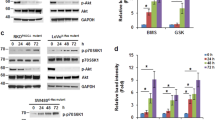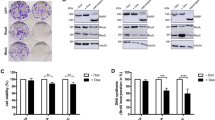Abstract
The inappropriate expression of TGFα in growth arrest contributes to malignant progression in human colon carcinoma cells. Early stage, non-progressed colon tumor cells show a down-regulation of TGFα in growth arrest and require both nutrients and growth factors for re-entry into the cell cycle. In contrast, highly progressed cells up-regulate TGFα during growth arrest and require only nutrients for re-entry. Given the importance of TGFα in malignant progression, this work addressed the regulation of TGFα expression in the early stage colon carcinoma cell line, FET. Growth-arrested FET cells down-regulated the expression of TGFα, EGFr and, in turn, EGFr activation. These quiescent cells continued to express high levels of IGF-IR protein, but IGF-IR activation was undetectable. Cell cycle re-entry required exogenous growth factor activation of the IGF-IR by insulin or IGF-I. This IGF-IR activation resulted in S phase re-entry and was accompanied by an approximate threefold induction of TGFα expression along with EGFr activation at 1 h following release from growth arrest. Activation of IGF-IR occurred within 5 min of cell-cycle re-entry. Previously identified DNA binding proteins which bind to a unique TGFα/EGF response element within the TGFα promoter were similarly induced following IGF-IR activation. The addition of EGFr neutralizing antibodies abolished the activated IGF-IR stimulated S phase re-entry. Moreover, disruption of the growth arrest associated down-regulation of TGFα in FET cells by constitutive TGFα expression abrogated the requirement for IGF-IR activation for cell cycle re-entry. Consequently, this study indicates, for the first time, that IGF-IR activation up-regulates components of the TGFα autocrine loop resulting in TGFα-mediated EGFr activation which was critical for IGF-IR mediated re-entry into the cell cycle from the growth-arrested state.
This is a preview of subscription content, access via your institution
Access options
Subscribe to this journal
Receive 50 print issues and online access
$259.00 per year
only $5.18 per issue
Buy this article
- Purchase on Springer Link
- Instant access to full article PDF
Prices may be subject to local taxes which are calculated during checkout









Similar content being viewed by others
References
Bates SE, Valerius EM, Ennis BWD, Bronzert A, Sheridan JP, Stampfer MR, Mendelsohn J, Lippman ME, Dickson RB . 1990 Endocrinology 126: 596–607
Blakesley VA, Stannard BS, Kalebic T, Helman LJ, LeRoith D . 1997 J. Endocrinol. 152: 339–344
Boyd D, Levine AE, Brattain DE, McKnight MK, Brattain MG . 1988 Cancer Res. 48: 2469–2474
Brattain MG, Brattain DE, Fine WD, Khaled FM, Marks ME, Kimball PM, Arcolano LA, Danbury BH . 1981 Oncodev. Biol. Med. 2: 355–366
Brattain MG, Howell G, Sun LZ, Willson JKV . 1994 Curr. Opin. Oncol. 6: 77–81
Brattain MG, Levine AE, Chakrabarty S, Yeoman LC, Willson JKV, Long B . 1984 Cancer Metastasis Rev. 3: 177–191
Campos-Gonzalez R, Glenney Jr JR . 1991a Cell. Reg. 2: 663–673
Campos-Gonzalez R, Glenney Jr JR . 1991b Growth Factors 4: 305–316
Chantret I, Barbat A, Dussaulx E, Brattain MG, Zweibaum A . 1988 Cancer Res. 48: 1936–1942
Chirgwin JM, Przybyla AE, MacDonald RJ, Rutter WJ . 1979 Biochemistry 18: 5294–5299
Coffey RJ, Graves-Deal R, Dempsey PJ, Whitehead RH, Pittelkow MR . 1992 Cell Growth Differ. 3: 347–354
Coppola D, Ferber A, Miura M, Sell C, D'Ambrosio C, Rubin R, Baserga R . 1994 Mol. Cell. Biol. 14: 4588–4595
Dignam JD, Lebowitz RM, Roeder RG . 1983 Nucl. Acids Res. 11: 707–712
DeLarco JE, Todaro GJ . 1978 Proc. Natl. Acad. Sci. USA 75: 4001–4005
Derynck R, Goeddel DVM, Ullrich A, Gutterman JU, Williams RD, Bringman TS, Berger WH . 1987 Cancer Res. 47: 707–712
Enoch T, Zinn K, Maniatis T . 1986 Mol. Cell. Biol. 6: 801–810
Gorski K, Carneireo M, Schibler U . 1986 Cell 47: 767–776
Gossen M, Bujard H . 1992 Proc. Natl. Acad. Sci. USA. 89: 5547–5551
Howell GM, Humphrey LE, Ziober BL, Awwad R, Periyasamy B, Koterba A, Li W, Willson JKV, Coleman K, Carboni J, Lynch M, Brattain MG . 1998 Mol. Cell. Biol. 18: 303–313
Howell GM, Ziober BL, Humphrey LE, Willson JKV, Sun L, Lynch M, Brattain MG . 1995 J. Cell Physiol. 162: 256–265
Huebers HA, Finch CA . 1987 Physiol. Rev. 67: 520–582
Jiang D, Yang H, Willson JKV, Liang J, Humphrey LE, Zborowska E, Wang D, Foster J, Fan R, Brattain MG . 1998 J. Biol. Chem. 273: 31471–31479
Khazaie K, Schirrmacher V, Lichtner RB . 1993 Cancer Metastasis Rev. 12: 255–274
Levitzki A, Gazit A . 1995 Science 267: 1782–1788
Liu SC, Woo A, Tsao MS . 1990 Br. J. Cancer 62: 425–429
McClain DA, Paterson AJ, Roos MD, Wei X, Kudlow JE . 1992 Proc. Natl. Acad. Sci. USA 89: 8150–8154
Mulder KM . 1991 Cancer Res. 51: 2256–2262
Mulder KM, Brattain MG . 1989 Mol. Endocrinol. 3: 1215–1222
Pietrzkowski Z, Lammers R, Carpenter G, Soderquist AM, Limardo M, Phillips PD, Ullrich A, Baserga R . 1992 Cell Growth Differ. 3: 199–205
Pittelkow MR, Cook PW, Shipley GD, Derynck R, Coffey Jr RJ . 1993 Cell Growth Differ. 4: 513–521
Roos MD, Han IO, Paterson AJ, Kudlow JE . 1996 Am. J. Physiol. 270: 803–811
Sandgren EP, Luetteke NC, Palmitter RD, Brinster RL, Lee DC . 1990 Cell 61: 1121–1135
Sayeski PP, Kudlow JE . 1996 J. Biol. Chem. 271: 15237–15243
Scheidereit C, Heguy A, Roeder RG . 1987 Cell 51: 783–793
Schlechte W, Brattain M, Boyd D . 1990 Cancer Commun. 2: 173–179
Schmid D . 1995 Cell Biol. Int. 19: 445–457
Stewart AJ, Johnson MD, May FE, Westly BR . 1990 J. Biol. Chem. 265: 21172–21178
Tanaka S, Imanishi K, Yoshihara M, Haruma K, Sumii K, Kajiyama G, Akamatsu S . 1991 Am. J. Pathol. 139: 123–129
Vassar R, Fuchs E . 1991 Genes Dev. 5: 714–727
Werner H, LeRoith D . 1996 Adv. Cancer Res. 68: 183–223
Wu SP, Theodorescu D, Kerbel R, Willson JKV, Mulder KM, Humphrey LE, Brattain MG . 1992 J. Cell Biol. 116: 187–196
Yang H, Jiang D, Wenhui L, Liang J, Gentry LE, Brattain MG . 2000 Oncogene 19: 1901–1914
Ziober BL, Willson JKV, Humphrey LE, Childress-Fields K, Brattain MG . 1993 J. Biol. Chem. 268: 691–698
Acknowledgements
The authors thank Ms Lorraine Gilmore for preparation of the manuscript. This work was supported by NIH grants CA34432 and CA54870. Degeng Wang performed in partial fulfillment of the requirement for the PhD in biomedical sciences from the Medical College of Ohio.
Author information
Authors and Affiliations
Corresponding author
Rights and permissions
About this article
Cite this article
Wang, D., Patil, S., Li, W. et al. Activation of the TGFα autocrine loop is downstream of IGF-I receptor activation during mitogenesis in growth factor dependent human colon carcinoma cells. Oncogene 21, 2785–2796 (2002). https://doi.org/10.1038/sj.onc.1205375
Received:
Revised:
Accepted:
Published:
Issue Date:
DOI: https://doi.org/10.1038/sj.onc.1205375
Keywords
This article is cited by
-
Akt inhibitor MK-2206 promotes anti-tumor activity and cell death by modulation of AIF and Ezrin in colorectal cancer
BMC Cancer (2014)
-
Cross-Talk Between the ErbB/HER Family and the Type I Insulin-Like Growth Factor Receptor Signaling Pathway in Breast Cancer
Journal of Mammary Gland Biology and Neoplasia (2008)
-
Growth factor signalling in endocrine and anti-growth factor resistant breast cancer
Reviews in Endocrine and Metabolic Disorders (2007)
-
RETRACTED ARTICLE: Quinoxaline 1,4-dioxides induce G2/M cell cycle arrest and apoptosis in human colon cancer cells
Cancer Chemotherapy and Pharmacology (2005)
-
The role of the insulin-like growth factor system in colorectal cancer: review of current knowledge
International Journal of Colorectal Disease (2005)



